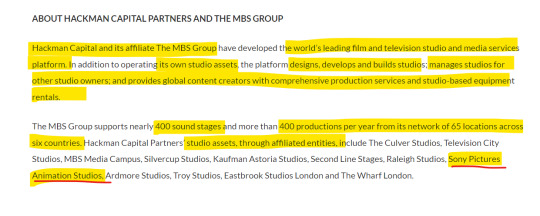#Contract Research and Manufacturing Services
Explore tagged Tumblr posts
Text

OctaneX Labs, a youthful and innovative chemistry-focused company, excels in creating advanced processes for synthesizing and manufacturing a wide array of products and compounds. Their expertise spans across the Pharma, Agro, Fine, and Specialty Chemicals industries, along with CRO and CDMO sectors. The company takes on Custom Development projects and provides Contract Research and Manufacturing Services (CRAMS) to clients worldwide. OctaneX Labs has developed numerous intermediates, including crucial raw and starting materials, making them a reliable partner for contract research synthesis in all areas of Organic and Medicinal Chemistry.
#cdmo#chemicals#chemistry#cro#healthcare#science#cdmo companies in india#cdmo services#chemical synthesis#cro services#medicinal chemistry#chemicals industry#raw materials for chemicals#Custom Development projects#Contract Research and Manufacturing Services
0 notes
Link
In the pharmaceutical industry, Contract Research and Manufacturing Services (CRAMS) is a commonly used term. These services are provided by third-party companies to the pharmaceutical industry to perform research and development, manufacturing, and other related services.
0 notes
Text
Pharma API Manufacturing Sites & Capabilities | CDMO Company | CRO | Aurigene Pharmaceutical Services

We operate 8 API manufacturing sites. Each of these sites has a dedicated facilities associated with capacity, capability, desired market, & appropriate regulatory status.
To know more:https://www.aurigeneservices.com/services/manufacturing/sites-and-capabilities
#api manufacturing#api drug development#API manufacturing sites#API manufacturing capabilities#contract research services#contract research organization#api manufacturing facilities
0 notes
Text
CRAMS Revolution: Riding the Wave of Innovation in a $132.8 Billion Sector

Experience the CRAMS revolution in the $132.8 billion sector. Explore market size, segmentation, trends, and reports, along with opportunities and challenges shaping the contract research and manufacturing services industry.
#contract research and manufacturing services Market#CRAMS Market#CRAMS Industry#CRAMS Sector#CRAMS Market Size#CRAMS Market Segmentation#CRAMS Market Trends#CRAMS Market Report#Opportunities in CRAMS Industry#Challenges in CRAMS market#CRAMS Market Forecast#CRAMS Market Major Players#CRAMS Market Analysis#CRAMS Market Revenue#CRAMS Market Growth Rate#CRAMS Market Future Outlook
0 notes
Text
Athletes Go for the Gold with NASA Spinoffs
NASA technology tends to find its way into the sporting world more often than you’d expect. Fitness is important to the space program because astronauts must undergo the extreme g-forces of getting into space and endure the long-term effects of weightlessness on the human body. The agency’s engineering expertise also means that items like shoes and swimsuits can be improved with NASA know-how.
As the 2024 Olympics are in full swing in Paris, here are some of the many NASA-derived technologies that have helped competitive athletes train for the games and made sure they’re properly equipped to win.

The LZR Racer reduces skin friction drag by covering more skin than traditional swimsuits. Multiple pieces of the water-resistant and extremely lightweight LZR Pulse fabric connect at ultrasonically welded seams and incorporate extremely low-profile zippers to keep viscous drag to a minimum.
Swimsuits That Don’t Drag
When the swimsuit manufacturer Speedo wanted its LZR Racer suit to have as little drag as possible, the company turned to the experts at Langley Research Center to test its materials and design. The end result was that the new suit reduced drag by 24 percent compared to the prior generation of Speedo racing suit and broke 13 world records in 2008. While the original LZR Racer is no longer used in competition due to the advantage it gave wearers, its legacy lives on in derivatives still produced to this day.

Trilion Quality Systems worked with NASA’s Glenn Research Center to adapt existing stereo photogrammetry software to work with high-speed cameras. Now the company sells the package widely, and it is used to analyze stress and strain in everything from knee implants to running shoes and more.
High-Speed Cameras for High-Speed Shoes
After space shuttle Columbia, investigators needed to see how materials reacted during recreation tests with high-speed cameras, which involved working with industry to create a system that could analyze footage filmed at 30,000 frames per second. Engineers at Adidas used this system to analyze the behavior of Olympic marathoners' feet as they hit the ground and adjusted the design of the company’s high-performance footwear based on these observations.

Martial artist Barry French holds an Impax Body Shield while former European middle-weight kickboxing champion Daryl Tyler delivers an explosive jump side kick; the force of the impact is registered precisely and shown on the display panel of the electronic box French is wearing on his belt.
One-Thousandth-of-an-Inch Punch
In the 1980s, Olympic martial artists needed a way to measure the impact of their strikes to improve training for competition. Impulse Technology reached out to Glenn Research Center to create the Impax sensor, an ultra-thin film sensor which creates a small amount of voltage when struck. The more force applied, the more voltage it generates, enabling a computerized display to show how powerful a punch or kick was.

Astronaut Sunita Williams poses while using the Interim Resistive Exercise Device on the ISS. The cylinders at the base of each side house the SpiraFlex FlexPacks that inventor Paul Francis honed under NASA contracts. They would go on to power the Bowflex Revolution and other commercial exercise equipment.
Weight Training Without the Weight
Astronauts spending long periods of time in space needed a way to maintain muscle mass without the effect of gravity, but lifting free weights doesn’t work when you’re practically weightless. An exercise machine that uses elastic resistance to provide the same benefits as weightlifting went to the space station in the year 2000. That resistance technology was commercialized into the Bowflex Revolution home exercise equipment shortly afterwards.
Want to learn more about technologies made for space and used on Earth? Check out NASA Spinoff to find products and services that wouldn’t exist without space exploration.
Make sure to follow us on Tumblr for your regular dose of space!
2K notes
·
View notes
Text
The Business Research Company offers contract research and manufacturing services (crams) market research report 2023 with industry size, share, segments and market growth
#global contract research and manufacturing services (crams) market#contract research and manufacturing services (crams) market size#contract research and manufacturing services (crams) market share#contract research and manufacturing services (crams) market growth#contract research and manufacturing services (crams) market trends#contract research and manufacturing services (crams) market overview#contract research and manufacturing services (crams) market outlook#contract research and manufacturing services (crams) market analysis#contract research and manufacturing services (crams) market report#contract research and manufacturing services (crams) market research#contract research and manufacturing services (crams) industry#contract research and manufacturing services (crams) market forecast
0 notes
Text
A word on Wardpark/Cumbernauld Studios
@docsama left a comment, on S's birthday, under one of my posts and I promised her an answer with more information, as soon as I got the time. Anyway, here goes - and @docsama, sorry for the delay:

Question is: who owns the Wardpark Film and Television Studios?
The answer was quick to find, in the not-so-old specialized media:


The story begins in 2013, with an ambitious Scottish entrepreneur, Terry Thomson - this guy (courtesy of The Herald, https://www.heraldscotland.com/news/15984820.analysis-three-projects-pipeline-help-productions-make-big-picture/):

He is the owner of the Thomson Pettie Group, based in Carluke (https://www.thomsonpettie.com/about-us), which has nothing to do with cinema:

You've read that right: they are 'manufacturers of fabricated metal parts and assemblies', primarily for the national automotive industry. Yet, in 2013, Mr. Thomson agreed to rent what he described as 'a dormant industrial property' - a warehouse, to be exact - to Sony, in order to host the filming and production of OL. Thus, he became the CEO of a newly created entity, The Wardpark Film and Television Studios (https://www.hackmancapital.com/scotlands-largest-most-iconic-film-studio-acquired-by-hackman-capital-partners-and-square-mile-capital/).
By 2017, Wardpark was doing so well, that a big expansion plan was announced, with the direct support of the Scottish Government, which invested £4 million via Scottish Enterprise, its business support, advice and funding agency:

And then, in November 2021, the little engine that could was sold to those two big US investors, Hackman Capital Partners (HCP) and Square Mile Capital Management LLC (now globally rebranded as Affinius Capital). In this montage, Hackman Capital Partners brought its own confirmed film studios and media management expertise...

... while Square Mile most probably funded a sizeable portion of the acquisition, simply because this is what they do best:

Perhaps an interesting detail: HCP owns and manages both the Culver City based Sony Pictures Animation Studios' Campus and the legendary Culver Studios, now rebranded by Amazon:

Back to Scotland, Wardpark Studio's sale made just about everyone happy. Mr. Thomson kept his CEO job and look who was more than thrilled about the juicy transaction:

Currently, the studio is operated by HCP's subsidiary, The MBS Group:

That means that MBS probably manages just about everything, as far as daily management is concerned, from business operations, staffing and/or property management, to lighting and grip, trucks and generators' fleet, expendables and props. Unless I could see a contract and have a precise idea, I can just enumerate all the services they offer.
At no point in time did S and C own anything of those studios. As for the Executive Producer part, that is another discussion entirely. I could be coaxed to write something about it, if you really want to know why Those Two are EPs and what does that really, really mean - because once again, I have seen and read a LOT of bullshit in here, especially in the Desperate Housewives Disgruntled Tumblrettes' corner.
Thank you for asking. It was fun to research and write and I hope it brought more clarity to you.
100 notes
·
View notes
Text
There is much concern that Elon Musk’s Starlink intends to provide satellite internet coverage to the United States following the failure of its Red Sea “Operation Prosperity Guardian” alliance to curb Yemen’s pro-Palestinian front.
This conversation has gained traction since the company’s announcement on 18 September that it would launch services in Yemen after months of informal contracts with the Saudi-backed government in Aden. The timing of this announcement raised eyebrows, especially as it coincided with Israel’s terrorist attacks in Lebanon, involving exploding pagers and walkie-talkies.
[...]
The announcement that Yemen would be the first country in West Asia to have full access to its services surprised many – particularly because the US embassy in Yemen was quick to praise the move as an “achievement” that could unlock new opportunities.
[...]
The rival Sanaa government, under which most of Yemen’s population lives, was quick to warn that the Starlink project may threaten Yemen and its national security. Mohammed al-Bukhaiti, a member of Ansarallah’s political bureau, criticized the US embassy’s stance, which he says:
"Confirms the relationship between the launch of Starlink and the war launched by America on Yemen, which threatens to expand the conflict to the orbits of outer space for the first time in history."
[...]
In March, the Financial Times reported that the US and UK faced intelligence shortfalls in their Red Sea campaign, particularly around the capabilities of the Ansarallah-aligned forces’ arsenal. This intelligence gap underlined the west’s need for a reliable spy network, and Starlink’s role in this context raises serious questions.
A Reuters report revealed that SpaceX had signed secret contracts with the US Department of Defense aimed at developing a spy satellite system capable of detecting global threats in real-time.
[...]
Another concerning aspect is the involvement of Israel. Israel’s spy satellites, OFEK-13 and OFEK-14, are reportedly linked to Starlink’s satellite network. SpaceX, as a third party, may provide critical guidance and intelligence to these satellites, further enhancing Tel Aviv’s surveillance capabilities in the region. This connection between Starlink and Israeli intelligence efforts has heightened fears in Yemen that the satellite network will be used to undermine the country’s security and sovereignty.
Currently, Starlink services are available primarily in Yemeni areas controlled by the Saudi and UAE-led coalition, although roaming packages allow temporary access in other regions. This has prompted concerns about data security, privacy, and the spread of misinformation, as unrestricted satellite internet bypasses local government control.
[...]
Moreover, cybersecurity risks are particularly troubling, as the network might be exploited for dangerous purposes, including facilitating terrorist activities like bombings. The presence of a global satellite internet service that bypasses local regulations raises concerns about its potential to disrupt local internet infrastructure.
Starlink could also introduce unfair competition to local provider Yemen Net, further marginalizing the national telecom provider and hindering local development efforts.
[...]
Dr Youssef al-Hadri, a right-wing political affairs researcher, shared his views with The Cradle on the recent events in Lebanon and the ongoing electronic warfare involving the US and its allies. According to Hadri, intelligence agencies operating in areas under the control of the Sanaa government face challenges in detecting the locations of missiles, drones, and military manufacturing sites.
This shortfall became even more apparent after a major intelligence operation exposed a long-running spy cell in Yemen, with activities spanning across multiple sectors.
From the risk of espionage to the undermining of local telecom providers, the implications of Starlink’s operations extend far beyond providing internet access – they could become a vehicle for foreign influence and control.
[...]
3 Oct 2024
13 notes
·
View notes
Text
Bioterror Propaganda Roundup: The latest updates on the “new normal” – chronicling the lies, distortions, and abuses by the ruling class.
Biden awards hundreds of millions for bird flu tests, ‘research into potential medical countermeasures’
Lady Dr. Jill (not a real doctor) or Antony Blinken or some disembodied Oz-type voice on the White House intercom system or whoever runs the shitshow over there has heard the pleas from CCP bioterrorist Leana Wen to ramp up the PCR fraud in the runup to the full-on Pandemic 2.0, which I covered a few days ago, and acquiesced using other people’s money (or more accurately, money that doesn’t actually exist, tacked onto the bloated deficit).
Related: HHS Set to Roll Out Bird Flu Vaxes by the Millions
Via U.S. Department of Health and Human Services (HHS) (emphasis added):
“Today, the U.S. Department of Health and Human Services (HHS) announced it would award $306 million dollars to continue its H5N1 Avian Flu response. While CDC’s assessment of the risk of avian influenza to the general public remains low, USDA and HHS continue to closely collaborate with Federal, State, local, industry and other stakeholders to protect human health, animal health, and food safety… CDC will award approximately $111 million in funding for additional enhancements to our ability to monitor H5N1 at the local, state and national levels: $103 million to jurisdictions for increased monitoring of individuals exposed to infected animals, testing, and outreach to high-risk populations (such as livestock workers) $8 million to manufacture, store, and distribute additional influenza diagnostic test kits for virologic surveillance NIH will award approximately $11 million in funding for additional research into potential medical countermeasures for H5N1: $11 million to the Centers for Excellence for Influenza Research and Response contracts”
7 notes
·
View notes
Text

Name: Moth
Model: MTH-9L
Manufacturer: Ceres Metals Industries
Intro Year: 3145
Class: Light Battlemech
Cost: 4.677 mn c-bills
Weight: 30 T
Top Speed: 97.2 kph
Jump Capacity: 240 meters
Quirks: difficult to maintain, no/minimal arms, nimble jumper
In the wake of the 6th Andurian War, the Strategios of the Capellan Confederation Armed Forces determined that there was a need for a new, low cost light mech to serve as a forward observer and harassment unit in their augmented companies. While the venerable Raven remained in service, its relatively low speed and expensive suite of electronics lead to a number of costly losses during the conquest of Wallacia. To that end, specifications for a new scout were sent out for bids- the new mech had to be cheap, difficult for Free Worlds League precision energy weapons to engage with, and capable of engaging and providing support for indirect fire elements of the CCAF at a variety of ranges. Unusually, despite Hellespont Industrials, the Confederation's more seasoned light manufacturer, submitting a bid in the form of the Sunfire, Ceres Metals Industries won the contract. Their design, initially named Project GOSSAMER, was delayed several times due to production shortfalls and the discovery of a Federated Suns spy ring operating at Ceres' design bureau. Eventually the mech began full production in 3145 as the Moth.
An outwardly radical design, Ceres managed to reduce the cost of their bid significantly through the use of a number of off the shelf parts and existing research prototypes. The mech's engine was a GM 180 extralight fusion power plant, originally designed for a prototype Vindicator before the VND-4L project opted for a larger 225 power plant instead, allowing the 30 ton mech to achieve ground speeds of up to 97 kph. While this speed was deemed unacceptable for the task at hand, the mech's principle designer, Dr. Oxana Ufimtsev, opted to equip the mech with a battery of Anderson jump jets and used a novel delta design for the main hull of the mech, with very low profile arms and wide, integrated control surfaces to give the mech an unusually high glide coefficient. Together, these systems allow the Moth to leap distances similar to those achievable by the Spider, despite the mech's far less powerful engine. The cost of this innovative design is a frame with extremely cumbersome access points and systems not immediately intuitive to most mechtechs, leading to increased maintenance costs and repair times. When deployed in augmented formations alongside aerospace assets, technicians are commonly cross trained on both the unit's fighters and Moths, as the two repair schedules have been found to be similar.
The production model MTH-9L Moth uses a Moscovia light PPC as its main armament, supported by a pair of Ceres Arms model JX small pulse lasers mounted in the two weapons nacels that comprise the design's arms. Additionally, the mech carries a Diverse Optics ER small laser in the left arm and an Apple Churchill TAG system in the left, imported from Hellespont's Sian facility. Clad in 6 tons of Ceres mk III Stealth Armor, the Moth is easily capable of withstanding light fire from enemy mechs while confounding longer range sensor returns. Unfortunately, to make room for the light PPC, Ceres opted to reduce the size and ammenities of the mech's cockpit, resulting in complaints from pilots assigned to the machine for long scouting patrols.
In combat, Moths are most typically used as long range harassment units, using their stealth armor and long jump range to maintain evade enemy fire as they opportunistically engage with their TAG and light PPC. As the fight progresses, some pilots may choose to engage in more active combat, allowing the indirect elements they're supporting to remove the majority of a target'a armor before attempting to destroy vulnerable exposed components with their small lasers
The first recorded combat involving a Moth occurred on Brisbane between elements of the First Victoria Rangers and a raiding force of the Concordat Commandos. Captain Curtis Bao deployed a lance of Moths to waylay the advance of a Taurian armored colum and allow for his own heavy units and combat vehicles to position themselves in foothills east of the TDF landing site. The light mechs caught the tank company and their mech escorts by surprise, outflanking the vehicles and engaging into their weaker side armor at long range with their PPCs while painting targets for Bao's LRM carriers and Thunderbolts. Eventually, the Commandos' mechs rallied and began to engage the stealthy light lance, forcing them to withdraw, however the action blunted the Taurian advance and allowed time for the Victoria Rangers to mount a successful defense of Brisbane's capital, Badwater. The surviving Moths then saw use as city fighters, their jumping capabilities allowing them to manuever easily though the urban fabric of Badwater while their X-pulse lasers let them to brutally engage Taurian infantry.
As a new design, very few variants or operators outside the Confederation have yet to be spotted. Beyond the CCAF, a few Capellan aligned mercenary commands have been allowed to officially purchase small numbers of the design, while the allied Magistracy of Canopus has managed to acquire a number of lances of the mech through unknown sources.
While their infiltration was discovered and rooted out before the full design was finalized, MIIO operatives did manage to steal plans for the early prototypes of the Moth, which the New Avalon Institute of Science used as a test bed for re-engineered laser designs and new SRM munitions. A small production run of the design, similar but without the Capellan stealth armor, was produced by Corean Enterprises at their Augusta plant, but the AFFS appears to have abandoned adding the mech to its TO&E.
Finally, several examples of the Moth were captured by forces loyal to Alaric Ward's Star League during fighting on New Earth. The Jade Falcon remnant present immediately saw use in the design as a heavier alternative to their light Ion Sparrows. A Clantech refit of the mech has been spotted using an ER large laser in place of the PPC and a quartet of small pulse lasers in the weapons nacels.
9 notes
·
View notes
Text

IMAGES: Fly the new USAF stealth bomber, the B-21 Raider
Fernando Valduga By Fernando Valduga 11/10/2023 - 15:14in Military
Photo: Matt Hartman
USAF's new B-21 “Raider” flying wing bomber made its first flight on Friday, the next step in the launch of a new fleet of nuclear-capable long-range stealth bombers built by Northrop Grumman.
The B-21 left the Northrop facility at U.S. Air Force Plant 42 in Palmdale, California, at sunrise on Friday at 6:51 a.m., offering the first improvised view of the new bomber that was developed under strict security.

The aircraft went to Edwards Air Base, California, where it will continue with the flight test phase with USAF. The flight lasted about 90 minutes.
With the Cerberus callsign, the aircraft took off eastward with an F-16 companion plane after climbing about 500 feet. The landing gear was not collected, according to videos and photos that appeared on social networks.
TAP TITLE BAR TO VIEW VIDEO☝️
U.S. Air Force leaders did not disclose the first flight of the B-21, but about three dozen aviation enthusiasts and amateur photographers gathered around Plant 42 on Friday in the hope of seeing the bomber rise to the skies.

Photo: Mike Henry
The B-21, which carries the same "flying wing" format as its predecessor, the B-2, will be able to launch conventional and nuclear weapons around the world, using long-range and in-flight refueling capabilities.
The aircraft are projected to cost approximately $550 million each in 2010 dollars, or about $750 million in current inflation-adjusted dollars. However, the USAF kept other price information confidential, “which makes it difficult to validate the proposed cost,” the Congressional Research Service said in a 2021 report.

Photo: Mike Henry
The U.S. Air Force plans to buy at least 100 planes and start replacing the B-1 and B-2 bombers. The B-1 costs about US$ 60,000 per hour to operate and the B-2 costs about US$ 65,000 per hour, according to Pentagon data.
Ann Stefanek, USAF spokesperson, said: “The B-21 Raider is in flight tests. Flight tests are a critical step in the testing campaign managed by the Air Force Test Center and the 412ª Combined Test Wings B-21 Test Force."

Photo: Mike Henry
Six test aircraft are being produced now. They are being built on the same line, using the tools, processes and technicians that will build the production aircraft.

Northrop defeated a team composed of Boeing and Lockheed Martin when it won the 2015 contract to manufacture the bomber. Engine manufacturer Pratt & Whitney, Collins Aerospace, GKN Aerospace, BAE Systems and Spirit Aerosystems are among more than 400 suppliers in 40 states.
The B-21 was publicly presented in December 2022, but the expectation around its first flight had been growing for years.
In 2019, an important Air Force general suggested that the bomber could fly as early as December 2021, but the Force subsequently postponed this date to mid-2022. In early 2022, the USAF postponed even more until 2023.
The B-21 program is in the engineering and manufacturing development phase and the first aircraft will be delivered to Ellsworth Air Force Base in North Dakota.

Northrop is calling the plane a sixth-generation aircraft due to its ability to connect to other aircraft and easily integrate future weapons into its systems architecture.

The B-21 also features surface material with low observation, more durable and stealthy, which should require less maintenance and reduce operating costs and downtime.
Tags: Military AviationNorthrop Grumman B-21 RaiderUSAF - United States Air Force / U.S. Air Force
Sharing
tweet
Fernando Valduga
Fernando Valduga
Aviation photographer and pilot since 1992, has participated in several events and air operations, such as Cruzex, AirVenture, Dayton Airshow and FIDAE. He has work published in specialized aviation magazines in Brazil and abroad. Uses Canon equipment during his photographic work in the world of aviation.
Related news
SAAB
Sweden will arm Gripen E fighters with anti-radar missiles
10/11/2023 - 18:00
DUBAI AIR SHOW
Russia will show the Il-76MD-90A and a line of civilian and combat helicopters at the Dubai Airshow
10/11/2023 - 17:00
MILITARY
Slovakia cancels military aid package to Ukraine
10/11/2023 - 14:00
MILITARY
Saab highlights Gripen E at a defense fair in Thailand
10/11/2023 - 09:00
The first Boeing T-7A Red Hawk, with the USAF test pilot Maj. Jonathan "Gremlin" Aronoff and Boeing test pilot Steve "Bull" Schmidt at the controls, arrive at Edwards Air Base on November 8, 2023 (Photo: U.S. Air Force / Todd Schannuth)
MILITARY
IMAGES: First T-7A Red Hawk arrives in Edwards to start the testing campaign with USAF
10/11/2023 - 08:10
MILITARY
Spain 'rejects' F-35 fighters and should focus on more Eurofighter Typhoons
09/11/2023 - 21:52
Client PortalClient PortalClient PortalClient PortalClient PortalClient PortalClient PortalClient PortalhomeMain PageEditorialsINFORMATIONeventsCooperateSpecialitiesadvertiseabout
Cavok Brazil - Digital Tchê Web Creation
Commercial
Executive
Helicopters
HISTORY
Military
Brazilian Air Force
Space
Specialities
Cavok Brazil - Digital Tchê Web Creation
26 notes
·
View notes
Text

Precision-Driven Solutions for the Pharma & Chemical Industry We excel in Pharma, Agro, Fine & Specialty Chemicals, CRO, and CDMO sectors, delivering tailored synthesis solutions backed by extensive global partnerships. Our focus on innovation, production efficiency, and market strategy drives industry-leading results.
#bioscience#OctaneX Labs#API clinical trial management system#intermediates manufacturers#chemicals API#fine chemical#synthesis#CDMO Companies#CDMO India#life science chemicals#pharmaceutical fine chemicals#capsules#chemicals#cro#cdmo#cdmo companies in india#cdmo services#science#chemical synthesis#chemistry#healthcare#cro services#speciality chemicals#fine chemistry#contract research#pharma company#pharma#pharmaceutical#big pharma#cro ind
0 notes
Link
0 notes
Text



Two new satellites added to Galileo constellation for increased resilience
The European Galileo satellite navigation system keeps growing: a new pair of satellites has joined the constellation after a journey on a Falcon 9 rocket, launched from the Kennedy Space Center in Florida on 18 September at 00:50 CEST (17 September 18:50 local time).
The 13th launch in the Galileo programme, performed by SpaceX under contract with ESA, has taken Galileo satellites number 31 and 32 (FM26 and FM32) to medium Earth orbit, extending the constellation to make it more robust and resilient. In the coming weeks, the new satellites will reach their final destination at 23 222 km, where they will be tested prior to starting operations.
ESA Director of Navigation Javier Benedicto said, “With the deployment of these two satellites, Galileo completes its constellation as designed, reaching the required operational satellites plus one spare per orbital plane. The remaining 6 Galileo First Generation satellites are expected to be deployed in 2025 and 2026 for increased robustness and performance, solidifying the resilience and reliability of Galileo and enabling uninterrupted delivery of the world’s most precise navigation.”
ESA, as design authority and system development prime, together with manufacturer OHB, has developed and tested 38 satellites since the conception of Galileo. All but six satellites have been launched, with the remaining ones ready to join the constellation starting next year. They will be launched in pairs by Ariane 6, ESA’s new launcher that successfully completed its inaugural flight in July. Thereafter, the first batch of Galileo Second Generation (G2) satellites, currently under development by Thales Alenia Space and Airbus Defence and Space, will also be placed in orbit by ESA’s heavy launcher.
Galileo, onwards and upwards
2024 has been a busy year in the Galileo programme, that moves ahead at full speed. In April, the first dual launch of the year placed satellites 29 and 30 in orbit. After a successful early orbit phase and test campaign, the pair entered into service in September.
Just a few days prior to the April launch, Galileo’s new Public Regulated Service (PRS) signals started broadcasting. This encrypted navigation service is specifically designed for authorised governmental users and sensitive applications, contributing to increase Europe’s autonomy and resilience in the critical domain of satellite navigation.
Also in April, Galileo’s ground segment, the largest in Europe and one of the continent’s most critical infrastructures, was migrated with no user impact. This upgrade was needed in part to prepare the system for Galileo’s Second Generation, that is being built by European industry. G2 satellites will be ground-breaking with fully digital navigation payloads, electric propulsion, a more powerful navigation antenna, inter-satellite link capacity and an advanced atomic clock configuration.
About Galileo
Galileo is currently the world’s most precise satellite navigation system, serving over four billion smartphone users around the globe since entering Open Service in 2017. All smartphones sold in the European Single Market are now guaranteed Galileo-enabled. In addition, Galileo is making a difference across the fields of rail, maritime, agriculture, financial timing services and rescue operations.
A flagship programme of the EU, Galileo is managed and funded by the European Commission. Since its inception, ESA, as system development prime and design authority, leads the design, development and qualification of the space and ground systems, and procures launch services. ESA is also entrusted with research and development activities for the future of Galileo within the EU programme Horizon Europe. The EU Agency for the Space Programme (EUSPA) acts as the system prime for the operational system provider, ensuring exploitation and safe and secure delivery of services while overseeing market demands and application needs.
6 notes
·
View notes
Text
Strange Chinese trade-war recommendations at US Congress
COMPREHENSIVE LIST OF THE COMMISSION’S 2024 RECOMMENDATIONS Part II: Technology and Consumer Product Opportunities and Risks Chapter 3: U.S.-China Competition in Emerging Technologies The Commission recommends:
Congress establish and fund a Manhattan Project-like program dedicated to racing to and acquiring an Artificial General Intelligence (AGI) capability. AGI is generally defined as systems that are as good as or better than human capabilities across all cognitive domains and would surpass the sharpest human minds at every task. Among the specific actions the Commission recommends for Congress:
Provide broad multiyear contracting authority to the executive branch and associated funding for leading artificial intelligence, cloud, and data center companies and others to advance the stated policy at a pace and scale consistent with the goal of U.S. AGI leadership; and
Direct the U.S. secretary of defense to provide a Defense Priorities and Allocations System “DX Rating” to items in the artificial intelligence ecosystem to ensure this project receives national priority.
Congress consider legislation to:
Require prior approval and ongoing oversight of Chinese involvement in biotechnology companies engaged in operations in the United States, including research or other related transactions. Such approval and oversight operations shall be conducted by the U.S. Department of Health and Human Services in consultation with other appropriate governmental entities. In identifying the involvement of Chinese entities or interests in the U.S. biotechnology sector, Congress should include firms and persons: ○ Engaged in genomic research; ○ Evaluating and/or reporting on genetic data, including for medical or therapeutic purposes or ancestral documentation; ○ Participating in pharmaceutical development; ○ Involved with U.S. colleges and universities; and ○ Involved with federal, state, or local governments or agen cies and departments.
Support significant Federal Government investments in biotechnology in the United States and with U.S. entities at every level of the technology development cycle and supply chain, from basic research through product development and market deployment, including investments in intermediate services capacity and equipment manufacturing capacity.
To protect U.S. economic and national security interests, Congress consider legislation to restrict or ban the importation of certain technologies and services controlled by Chinese entities, including:
Autonomous humanoid robots with advanced capabilities of (i) dexterity, (ii) locomotion, and (iii) intelligence; and
Energy infrastructure products that involve remote servicing, maintenance, or monitoring capabilities, such as load balancing and other batteries supporting the electrical grid, batteries used as backup systems for industrial facilities and/ or critical infrastructure, and transformers and associated equipment.
Congress encourage the Administration’s ongoing rulemaking efforts regarding “connected vehicles” to cover industrial machinery, Internet of Things devices, appliances, and other connected devices produced by Chinese entities or including Chinese technologies that can be accessed, serviced, maintained, or updated remotely or through physical updates.
Congress enact legislation prohibiting granting seats on boards of directors and information rights to China-based investors in strategic technology sectors. Allowing foreign investors to hold seats and observer seats on the boards of U.S. technology start-ups provides them with sensitive strategic information, which could be leveraged to gain competitive advantages. Prohibiting this practice would protect intellectual property and ensure that U.S. technological advances are not compromised. It would also reduce the risk of corporate espionage, safeguarding America’s leadership in emerging technologies.
Congress establish that:
The U.S. government will unilaterally or with key interna- tional partners seek to vertically integrate in the develop- ment and commercialization of quantum technology.
Federal Government investments in quantum technology support every level of the technology development cycle and supply chain from basic research through product development and market deployment, including investments in intermediate services capacity.
The Office of Science and Technology Policy, in consultation with appropriate agencies and experts, develop a Quantum Technology Supply Chain Roadmap to ensure that the United States coordinates outbound investment, U.S. critical supply chain assessments, the activities of the Committee on Foreign Investment in the United States (CFIUS), and federally supported research activities to ensure that the United States, along with key allies and partners, will lead in this critical technology and not advance Chinese capabilities and development....
6 notes
·
View notes
Text
The 6 Roles of Blockchain Technology in Pharma’s Future

Introduction
The pharmaceutical industry is undergoing a digital transformation, and blockchain technology is at the forefront of this revolution. Traditional challenges such as counterfeit drugs, regulatory inefficiencies, clinical trial fraud, and data breaches have long plagued the sector. Blockchain, with its decentralized and tamper-proof nature, offers solutions that can enhance security, transparency, and operational efficiency.
As blockchain development service providers continue refining solutions for pharma, companies are beginning to adopt this technology to streamline supply chains, enhance patient data security, and automate compliance. This article explores six critical roles that blockchain will play in shaping the future of the pharmaceutical industry.
1. Securing the Pharmaceutical Supply Chain
Eliminating Counterfeit Drugs
Counterfeit medications pose a significant threat to global health, contributing to thousands of deaths annually. The World Health Organization (WHO) estimates that one in ten medical products in low- and middle-income countries is substandard or falsified.
End-to-End Traceability
Blockchain technology enables a fully transparent supply chain, where each transaction is recorded in an immutable ledger. This ensures that every stakeholder—from manufacturers to pharmacists—can verify a drug’s authenticity in real-time.
Real-Time Verification
With blockchain-based tracking, patients, healthcare providers, and regulatory agencies can instantly verify the legitimacy of medications. Leading pharmaceutical companies like Pfizer and Roche are already exploring blockchain to secure drug distribution and eliminate counterfeit products from the market.
2. Enhancing Drug Safety and Regulatory Compliance
Immutable Drug Records
Regulatory compliance in the pharmaceutical industry requires strict adherence to safety protocols, but traditional record-keeping methods are prone to errors and fraud. Blockchain ensures that all drug-related data, including batch numbers, manufacturing dates, and storage conditions, are permanently recorded and cannot be altered.
Automated Compliance Monitoring
Smart contracts—self-executing digital agreements stored on the blockchain—can automate compliance checks, ensuring that drugs meet safety regulations before they reach the market. This reduces human error and enhances accountability.
Rapid Recalls and Alerts
When safety concerns arise, blockchain enables instant notifications and targeted recalls. Instead of relying on slow, paper-based tracking systems, companies can pinpoint affected batches within seconds, reducing risks to patients and minimizing financial losses.
3. Revolutionizing Clinical Trials and Research
Data Integrity and Security
Clinical trials are the foundation of medical innovation, but they are often plagued by fraud and inefficiencies. Blockchain ensures that trial data is immutable, preventing manipulation or selective reporting. This guarantees transparency and fosters trust in research findings.
Streamlined Patient Consent
Informed consent is a crucial aspect of clinical trials, yet traditional methods often lack security and efficiency. Blockchain-based smart contracts can automate consent management, ensuring that patients have full control over their participation while reducing administrative burdens for researchers.
Faster Drug Development
By securely sharing trial data among researchers, pharmaceutical companies, and regulatory agencies, blockchain accelerates the drug development process. Faster access to verified data can lead to quicker approvals, ultimately bringing life-saving medications to patients sooner.
4. Enabling Secure and Efficient
Automated Payments with Smart Contracts
The pharmaceutical industry involves complex financial transactions between manufacturers, insurers, healthcare providers, and distributors. Blockchain simplifies these transactions by using smart contracts to automate payments based on pre-set conditions.
Reduced Fraud and Corruption
Traditional financial systems in the pharma sector are susceptible to fraud and inefficiencies. Blockchain’s decentralized ledger eliminates intermediaries, ensuring transparent and corruption-free transactions.
DeFi in Pharma
Decentralized finance (DeFi) applications powered by blockchain could revolutionize pharmaceutical funding. Companies can leverage tokenized assets to raise funds for research and development, bypassing traditional banking limitations.
5. Improving Patient Data Security
Decentralized Electronic Health Records (EHR)
Patient data is often stored in centralized databases, making it vulnerable to cyberattacks. Blockchain provides a decentralized and encrypted framework where patients control their health records, granting access only to authorized healthcare providers.
Seamless Data Sharing
Healthcare providers often struggle with interoperability issues, leading to treatment delays. Blockchain allows for secure, real-time data sharing across hospitals, research institutions, and insurance providers, ensuring a more efficient healthcare ecosystem.
Enhanced Privacy Protections
With data breaches on the rise, blockchain’s encryption protocols enhance patient privacy, reducing the risk of identity theft and unauthorized access to sensitive medical information.
6. The Future of Blockchain in Pharma
AI and Blockchain Integration
The combination of artificial intelligence (AI) and blockchain could further optimize drug manufacturing, predicting supply and demand trends to reduce waste and inefficiencies.
Tokenized Incentives
Blockchain could introduce tokenized rewards for patients participating in clinical trials, encouraging greater involvement and leading to more diverse research data.
Decentralized Research Collaboration
Pharmaceutical companies, universities, and biotech startups could collaborate more efficiently using blockchain-based decentralized networks. This would eliminate data silos and accelerate groundbreaking medical discoveries.
Conclusion
Blockchain technology is revolutionizing the pharmaceutical industry, offering unprecedented levels of security, efficiency, and transparency. From securing supply chains and automating compliance to enhancing patient data security and accelerating drug development, blockchain is set to become an essential pillar of the pharma ecosystem. As blockchain development service providers continue to innovate, pharmaceutical companies that embrace this technology will be better positioned to lead in an increasingly digital and decentralized future. The adoption of blockchain is not just a technological upgrade—it is a necessary evolution for a safer, more efficient, and patient-centric pharmaceutical industry.
#blockchain#blockchain development services#blockchain development#blockchain in healthcare#supply chain management#supply chain#technologies#development
2 notes
·
View notes